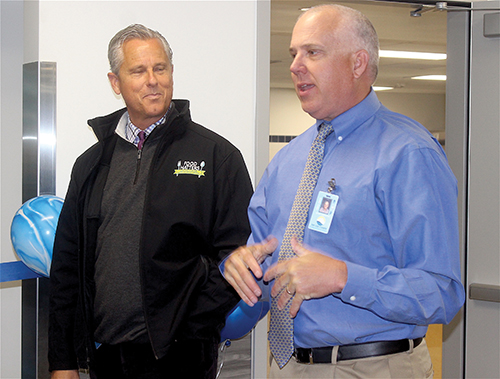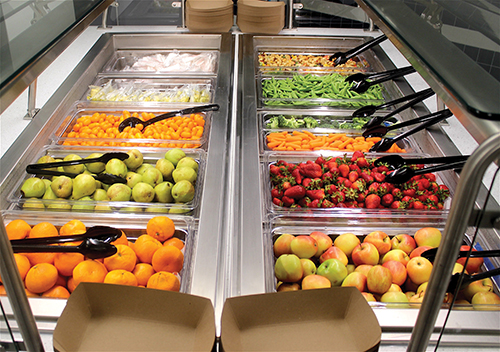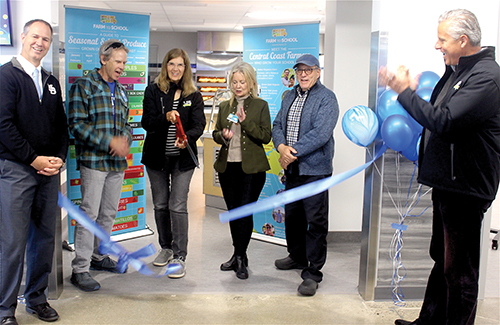MBHS Principal Scott Schalde; District Board of Trustees Member, Chris Ungar; Board Chairwoman, Ellen Sheffer; Trustee, Eve Dobler-Drew; and Trustee Mark Buchman and Superintendent, Eric Prater.
The latest improvement to open at Morro Bay High School will give students, faculty and staff a yummy treat at bargain basement prices.
The San Luis Coastal Unified School District turned out May 1 to christen a new café-style cafeteria and Common Room, the latest projects to be completed under 2014’s Measure D bond that’s been used to modernize and literally transform both Morro Bay and San Luis Obispo high schools.
District Trustees, administration and school staff gathered at the dining facility, which is located in what used to be the school library and Band Room. Just like the new theater that used to be the old cafeteria and multi-purpose room, the District’s massive work program has made new use of an old building.
The Common Room is impressive with large round tables and chairs and TVs on the walls. It’s got the feel of a lounge space, but with food ready to eat.

Coupled with the remodeled and greatly improved and spacious open quad just outside the cafeteria doors, plus the new theater, admin/student services building, athletic fields and track, and STEAM labs, the Pirates of today and future Pirates practically have a brand new school.
Assistant Superintendent, Ryan Pinkerton, addressing the assembled elected officials and City staffers, thanked everyone there and made special note of thanking the voters and taxpayers who voted to tax themselves and modernize the high schools calling it a big investment in education. “Measure D,” he said, “produced something as incredible as you stand in now.”
Board of Trustees Chairwoman, Ellen Sheffer did the honors cutting the ribbon and officially opened the new cafeteria and Common Room, which looks like something one might find at a college, not a small, high school with only about 840 students.
Assistant Director of Food Services, Kris Vander Weele gave a reporter a tour and rundown on how the kitchen works.

There’s a fruit and vegetable bar, presented like a salad bar, with locally sourced fruits and veggies, she explained. The kids can also pick an entrée from a short menu.
On opening day they offered three entrees — peperoni and jalapeño pizza slices, chow mien with dumplings, or locally sourced fish tacos with a homemade sauce and spring mix greens. It all looked very yummy.
The entree menu changes daily, and there are hot or cold breakfast foods in the mornings, Vander Weele said. There’s all state-of-the art kitchen equipment, she said, including a pizza oven, grill and chicken rotisserie oven. They also hired people on par with that equipment; people who know their way around a kitchen.
The Kitchen Supervisor at MBHS is Executive Chef Cory Bidwell, Vander Weele said, who was a chef at local restaurants for many years; and the supervisor at SLO High studied at the famous Le Cordon Bleu cooking school. The new cafeteria at SLO High will be comparable to this one, she explained but it isn’t finished yet.
The kitchen at SLO High will have to top Morro Bay’s output, as there are about 840 students here plus staffers, and some 1,600 students at SLOHS, which also has a larger staff.
This new concept of institutional cooking, and feeding school kids is nothing like what the current generation’s grandparents had, or even their parents.
And there’s another huge difference, all the food is free of charge for the students.
The school has “universal free meals,” Vander Weele said. It’s all included in the State budget allocations for schools. “They don’t have to pay for breakfast or lunch,” she added. The staff too can eat at the new cafeteria, but Vander Weele said they have to pay $3 per meal; still a bargain by any measure.
All a student has to do is show their MBHS student body card or punch in their ID number on the computer, Vander Weele said, and they can eat, choosing whatever strikes their fancy that day.
She noted that the prices they pay for all these foodstuffs are set by the U.S. Department of Agriculture (USDA). And they expect the costs will go up next year, she said. “All the food costs have gone up.”




